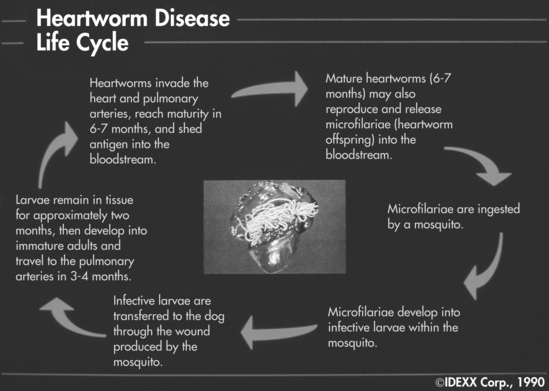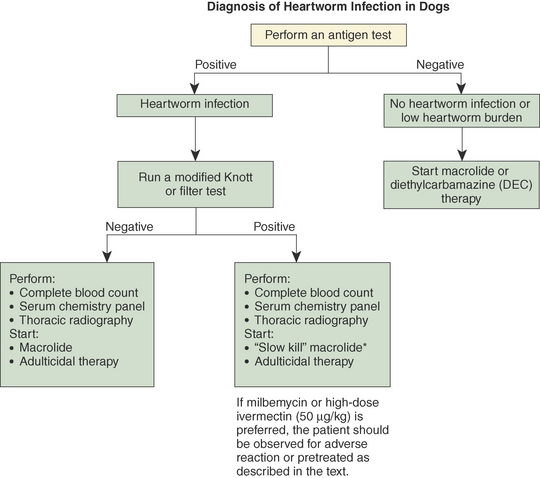Chapter 10 Heartworm Disease
HEARTWORM DISEASE
Etiology and Life Cycle
Canine Infection Life Cycle
Prevalence
Heartworm infection is most common in tropical and subtropical climates. Infection is inevitable in chronically unprotected dogs along the southern Atlantic and Gulf coasts and other highly endemic regions. The prevalence in cats varies by geographic region. It is much lower than dogs in some areas, similar to dogs in some areas, and the incidence is probably underestimated. Dogs housed outdoors have a four- to five-fold increased risk compared to those housed indoors. Infection is most common in dogs 4 to 7 years of age, but in highly endemic regions infection is common in younger dogs.
Pathogenesis
Clinical Signs
Dogs
Cats
Box 10-1 Clinical Signs Associated with Feline Heartworm Disease
Modified from Calvert C. Feline heartworm disease. In Fox PR, ed: Canine and feline cardiology, New York, 1988, Churchill Livingstone.
| Acute Signs | Chronic Signs |
| Sudden death* | PIE† syndrome |
| Respiratory | Coughing |
| Pulmonary embolism | Dyspnea |
| Collapse; shock | Cardiopulmonary |
| Hemoptysis | Lethargy |
| Dyspnea; cough | Weakness |
| Pneumonitis | Right-sided CHF‡ |
| Dyspnea; cough | Anorexia |
| Neurologic | Gastrointestinal |
| Blindness | Vomiting |
| Seizures | |
| Ataxia | |
| Coma | |
| Circling | |
| Syncope | |
| Gastrointestinal | |
| Vomiting |
* From severe pulmonary thromboembolism or heartworm occlusion of main pulmonary artery.
† Pulmonary infiltrates of eosinophilia.
Diagnosis
Laboratory Studies
Clinical Pathology
No abnormal test results are pathognomonic for heartworm infection.
Screening in Dogs
Screening in Cats
Stay updated, free articles. Join our Telegram channel

Full access? Get Clinical Tree




